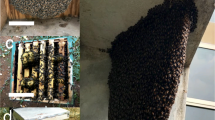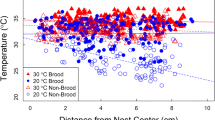Abstract
Simulation studies of the task threshold model for task allocation in social insect colonies suggest that nest temperature homeostasis is enhanced if workers have slightly different thresholds for engaging in tasks related to nest thermoregulation. Genetic variance in task thresholds is one way a distribution of task thresholds can be generated. Apis mellifera colonies with large genetic diversity are able to maintain more stable brood nest temperatures than colonies that are genetically uniform. If this phenomenon is generalizable to other species, we would predict that patrilines should vary in the threshold in which they engage in thermoregulatory tasks. We exposed A. florea colonies to different temperatures experimentally, and retrieved fanning workers at these different temperatures. In many cases we found statistically significant differences in the proportion of fanning workers of different patrilines at different experimental temperatures. This suggests that genetically different workers have different thresholds for performing the thermoregulatory task of fanning. We suggest, therefore, that genetically based variance in task threshold is a widespread phenomenon in the genus Apis.


Similar content being viewed by others
References
Beshers SN, Fewell JH (2001) Models of division of labor in social insects. Ann Rev Entomol 46:413–440
Beshers SN, Robinson GE, Mittenthal JE (1999) Response thresholds and division of labor in insect colonies. In: Detrain C, Deneubourg JL, Pasteels JM (eds) Information processing in social insects. Birkhauser Verlag, Basel, pp 115–139
Beshers SN, Huang ZY, Oono Y, Robinson GE (2001) Social inhibition and the regulation of temporal polyethism in honey bees. J Theor Biol 213:461–479
Bloch G, Toma DP, Robinson GE (2001) Behavioral rhythmicity, age, division of labor and period expression in the honey bee brain. J Biol Rhythms 16:444–456
Bonabeau E, Theraulaz G, Deneubourg J (1996) Quantitative study of the fixed threshold model for the regulation of division of labour in insect societies. Proc R Soc London B 263:1565–1569
Bonabeau E, Theraulaz G, Deneubourg J (1998) Fixed response thresholds and the regulation of division of labor in insect societies. Bull Math Biol 60:753–807
Calderone NW, Page REJ (1991) Evolutionary genetics of division of labor in colonies of the honey bee (Apis mellifera). Am Nat 138:69–92
Calderone NW, Robinson GE, Page REJ (1989) Genetic structure and division of labor in honeybee societies. Experientia 45:765–767
Elekonich MM, Schulz DJ, Bloch G, Robinson GE (2001) Juvenile hormone levels in honey bee (Apis mellifera L.) foragers: foraging experience and diurnal variation. J Insect Physiol 47:1119–1125
Estoup A, Solignac M, Cornuet J (1994) Precise assessment of the number of patrilines and of genetic relatedness in honeybee colonies. Proc R Soc Lond B 258:1–7
Giray T, Guzman-Novoa E, Aron CW, Zelinsky B, Fahrbach SE, Robinson GE (2000) Genetic variation in worker temporal polyethism and colony defensiveness in the honey bee, Apis mellifera. Behav Ecol 11:44–55
Graham S, Myerscough MR, Jones JC, Oldroyd BP (2006) Modelling the role of intracolonial genetic diversity on regulation of brood temperature in honey bee (Apis mellifera L.) colonies. Ins Soc 53:226–232
Huang ZY, Robinson GE (1999) Social control of division of labor in honey bee colonies. In: Detrain C, Deneubourg JL, Pasteels JM (eds) Information processing in social insects. Birkhauser Verlag, Basel, pp 165–186
Jones JC, Myerscough MR, Graham S, Oldroyd BP (2004) Honey bee nest thermoregulation: diversity promotes stability. Science 305:402–404
Leoncini I, Le Conte Y, Costagliola G, Plettber E, Toth AL, Wang MW, Huang Z, Becard JM, Crauser D, Slessor KN, Robinson GE (2004) Regulation of behavioral maturation by a primer pheromone produced by adult worker honey bees. Proc Natl Acad Sci USA 101:17559–17564
Meixner MD, Moritz RFA (2004) Clique formation of super-sister honeybee workers (Apis mellifera) in experimental groups. Ins Soc 51:43–47
Myerscough MR, Oldroyd BP (2004) Simulation models of the role of genetic variability in social insect task allocation. Ins Soc 51:146–152
Oldroyd BP, Rinderer TE, Buco SM (1992a) Intra-colonial foraging specialism by honey bees (Apis mellifera) (Hymenoptera: Apidae). Behav Ecol Sociobiol 30:291–295
Oldroyd BP, Rinderer TE, Harbo JR, Buco SM (1992b) Effects of intracolonial genetic diversity on honey bee (Hymenoptera: Apidae) colony performance. Ann Entomol Soc Am 85:335–343
Oldroyd BP, Rinderer TE, Buco SM, Beaman LD (1993) Genetic variance in honey bees for preferred foraging distance. Anim Behav 45:323–332
Oldroyd BP, Sylvester HA, Wongsiri S, Rinderer TE (1994) Task specialization in a wild bee, Apis florea (Hymenoptera: Apidae), revealed by RFLP banding. Behav Ecol Sociobiol 34:25–30
Oldroyd BP, Thompson GJ (2006) Behavioural genetics of the honey bee, Apis. Advances in insect physiology (in press)
Page RE, Laidlaw HH (1988) Full sisters and half sisters: a terminological paradigm. Anim Behav 36:944–945
Page RE, Robinson GE (1991) The genetics of division of labour in honey bee colonies. Advances in Insect Physiology 23:117–169
Page RE, Robinson GE, Calderone NW, Rothenbuhler WC (1989) Genetic structure, division of labor, and the evolution of insect societies. In: Breed MD, Page RE (eds) The genetics of social evolution. Westview, Boulder, pp 15–30
Palmer KA, Oldroyd BP (2000) Evolution of multiple mating in the genus Apis. Apidologie 31:235–248
Palmer KA, Oldroyd BP (2001) Mating frequency in Apis florea revisited (Hymenoptera, Apidae). Ins Soc 48:40–43
Rice W (1989) Analyzing tables of statistical tests. Evolution 43:223–225
Robinson GE (1992) Regulation of division of labor in insect societies. Ann Rev Entomol 37:637–665
Seeley TD (1985) Honeybee ecology a study of adaptation in social life. Princeton University Press, Princeton
Sokal RR, Rohlf FJ (1995) Biometry the principles and practice of statistics in biological research. W.H. Freeman and Company, New York
Sullivan JP, Jassim O, Fahrbach SE, Robinson GE (2000) Juvenile hormone paces behavioral development in the adult worker honey bee. Horm Behav 37:1–14
Theraulaz G, Bonabeau E, Deneubourg J (1998) Response threshold reinforcement and division of labour in insect societies. Proc R Soc Lond B 265:327–332
Weidenmuller A (2004) The control of nest climate in bumblebee (Bombus terrestris) colonies: interindividual variability and self reinforcement in fanning response. Behav Ecol 15:120–128
Weidenmuller A, Kleineidam C, Tautz J (2002) Collective control of nest climate parameters in bumblebee colonies. Anim Behav 63:1065–1071
Acknowledgments
We thank Nathan Lo, Madeleine Beekman, Graham Thompson, and Peter Oxley for helpful comments on the manuscript. We are grateful to Siriwat Wongsiri for his help with collecting the colonies. We are also grateful to Basil Panayotakos for constructing the dimmers for the infrared lamps. This study was funded by an Australian Research Council grant to Ben Oldroyd and Ross Crozier. Our experiments comply with the “Principles of animal care”, publication No. 86-23, revised 1985 of the National Institute of Health, and also with the current laws of Thailand where the experiments were performed.
Author information
Authors and Affiliations
Corresponding author
Rights and permissions
About this article
Cite this article
Jones, J.C., Nanork, P. & Oldroyd, B.P. The role of genetic diversity in nest cooling in a wild honey bee, Apis florea . J Comp Physiol A 193, 159–165 (2007). https://doi.org/10.1007/s00359-006-0176-8
Received:
Revised:
Accepted:
Published:
Issue Date:
DOI: https://doi.org/10.1007/s00359-006-0176-8




